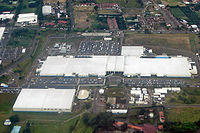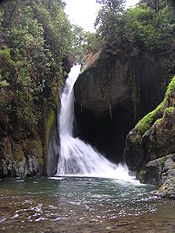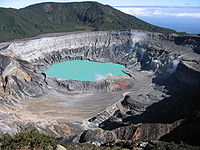- Economy of Costa Rica
-
Economy of Costa Rica Currency Costa Rican colón Fiscal year Leep Year Trade organisations CAFTA Statistics GDP $48.63 billion (2009) GDP growth -1.1% (2009) GDP per capita US$ 10,900 (2009) GDP by sector agriculture: 6.5% industry: 25.5% services: 68.0% (2008) Inflation (CPI) 8.3% (2009) Population
below poverty line21.3% (2010 est.)[1] Gini index 47.9 (1992-2007) Labour force 2.09 million (2009) Unemployment 7.8% (2009) Main industries microprocessors, food processing, medical equipment, textiles and clothing, construction materials, fertilizer, plastic products (2009) Ease of Doing Business Rank 125th[2] External Exports $8.847 billion (2009) Export goods bananas, pineapples, coffee, melons, ornamental plants, sugar; seafood; electronic components, medical equipment (2009) Main export partners US 23.9%, Netherlands 13.3%, China 13%, UK 5%, Mexico 4.9% (2008) Imports US$ 10.87 billion (2009) Import goods raw materials, consumer goods, capital equipment, petroleum, construction materials (2009) Main import partners US 42.7%, Mexico 6.9%, Venezuela 6.3%, Japan 5.4%, China 4.6%, Brazil 4.5% (2008) Public finances Public debt 49.3% of GDP (2009) Revenues US$3.795 billion (2009) Expenses US$4.908 billion (2009) Credit rating BB+ (Domestic)
BB (Foreign)
BBB- (T&C Assessment)
(Standard & Poor's)[3]Foreign reserves US$4.811 billion (March 2011)[4] All values, unless otherwise stated, are in US dollars The economy of Costa Rica heavily depends on tourism, agriculture, and electronics exports. Poverty has been reduced over the past 15 years, and a social safety net put into place. According to the CIA World Factbook, Costa Rica's GDP per capita is US$10,900 (2009); however, there is a lack of maintenance and new investment in infrastructure, 16% of the people living below the poverty line and 7.8% (2009) unemployed. The Costa Rican economy grew nearly 5% in 2006 after experiencing 4 years of slow economic growth.[not in citation given][5]
Inflation rose to 22.5% in 1995, dropped to 11.1% in 1997, 12% in 1998, 11% in 1999 and 13% in 2008. Measures taken by the Central Bank have reduced inflation substantially to 4.3% in 2009, and a projected 5.8% for 2010. Curbing inflation, reducing the deficit, and improving public sector efficiency through an anti-corruption drive, remain key challenges to the government. Previous political resistance to privatization had stalled liberalization efforts. However, after the signing of CAFTA, Costa Rica has now opened to competition its insurance and telecommunications markets.
Costa Rica's economy emerged from recession in 1997 and has shown strong aggregate growth since then. After 6.2% growth in 1998, GDP grew a substantial 8.3% in 1999, led by exports.Nat
The strength in the nontraditional export and tourism sector is masking a relatively lackluster performance by traditional sectors, including agriculture. The central government deficit decreased to 3.2% of GDP in 1999, down from 3.3% from the year before. On a consolidated basis, including Central Bank losses and parastatal enterprise profits, the public sector deficit was 2.3% of GDP.
Controlling the budget deficit remains the single biggest challenge for the country's economic policy makers, as interest costs on the accumulated central government debt consumes the equivalent of 30% of the government's total revenues. This limits the resources available for investments in the country's deteriorated public infrastructure, investments in many cases that would result in higher quality infrastructure if they were better planned.
Contents
Natural resources
Costa Rica's major economic resources are its fertile land and frequent rainfall, its well-educated population, and its location in the Central American isthmus, which provides easy access to North and South American markets and direct ocean access to the European and Asian Continents. Costa Rica has two seasons, both of which have their own agricultural resources: the tropical wet and dry seasons. One-fourth of Costa Rica's land is dedicated to national forests, often adjoining beaches, which has made the country a popular destination for affluent retirees and ecotourists.It has one of the best economies in Latin America In terms of the 2008 Environmental Performance Index ranking, Costa Rica is 5th in the world, up from the 15th place in 2006.[6]
Tourism
With a $1.92-billion-a-year tourism industry, Costa Rica stands as the most visited nation in the Central American region, with 1.9 million foreign visitors in 2007,[7] thus reaching a rate of foreign tourists per capita of 0.46, one of the highest in the Caribbean Basin, and above other popular destinations such as Mexico (0.21), Dominican Republic (0.38), and Brazil (0.03).
Ecotourism is extremely popular with the many tourists visiting the extensive national parks and protected areas around the country. Costa Rica was a pioneer in this type of tourism and the country is recognized as one of the few with real ecotourism.[8] Other important market segments are adventure, and sun and beaches. Most of the tourists come from the U.S. and Canada (46%), and the E.U. (16%),[9] the prime market travelers in the world, which translates into a relatively high expenditure per tourist of $1000 per trip. In terms of 2008 Travel and Tourism Competitiveness Index (TTCI), Costa Rica reached the 44th place in the world ranking, being the first among Latin American countries, and second if the Caribbean is included.[10] Just considering the subindex measuring human, cultural, and natural resources, Costa Rica ranks in the 24th place at a worldwide level, and 7th when considering just the natural resources criteria. The TTCI report also notes Costa Rica's main weaknesses, ground transport infrastructure (ranked 113th), and safety and security (ranked 128th).[11] [12]
Exports, jobs, and energy
 Intel microprocessor facility in Costa Rica is responsible for 20% of exports and 4,9% of the country's GDP.
Intel microprocessor facility in Costa Rica is responsible for 20% of exports and 4,9% of the country's GDP.
Costa Rica used to be known principally as a producer of bananas and coffee. Even though coffee, bananas, pineapple, sugar, lumber, wood products and beef are still important exports, in recent times electronics, pharmaceuticals, financial outsourcing, software development, and ecotourism have become the prime industries in Costa Rica's economy. High levels of education among its residents make the country an attractive investing location.
The country has successfully attracted important investments by such companies as Intel Corporation, which employs nearly 3,500 people at its custom built $300 million microprocessor plant; Procter & Gamble, which is establishing its administrative center for the Western Hemisphere in Costa Rica; and Abbott Laboratories and Baxter Healthcare from the health care products industry likewise. Manufacturing and industry's contribution to GDP overtook agriculture over the course of the 1990s, led by foreign investment in Costa Rica's free trade zones. Well over half of that investment has come from the U.S. In 2006 Intel's microprocessor facility alone was responsible for 20% of Costa Rican exports and 4.9% of the country's GDP.[13][14]
Trade with South East Asia and Russia has boomed during 2004 and 2005, and the country obtained full Asia-Pacific Economic Cooperation Forum (APEC) membership by 2007 (the country became an observer in 2004). In 2011 the Financial Times Intelligent Unit awarded Costa Rica with the fDi’s Caribbean and Central American Country of the Future 2011/12 for its successful record in attracting FDI into the country, and being the number one destination country in the region in terms of foreign direct investment (FDI) project numbers since 2003. In the previous assessment for the 2009/10 ranking the country had ranked second after Puerto Rico.[15][16]
Tourism is booming, with the number of visitors up from 780,000 in 1996, through 1 million in 1999, to 2.089 million foreign visitors in 2008, allowing the country to earn $2.144-billion in that year.[17] Tourism now earns more foreign exchange than bananas and coffee combined.[18] In 2005, tourism contributed with 8,1% of the country's GDP and represented 13,3% of direct and indirect employment.[19]
The country has not discovered sources of fossil fuels—apart from minor coal deposits—but its mountainous terrain and abundant rainfall have permitted the construction of a dozen hydroelectric power plants, making it self-sufficient in all energy needs, except oil for transportation. Costa Rica exports electricity to Central America and has the potential to become a major electricity exporter if plans for new generating plants and a regional distribution grid are realized. Mild climate and trade winds make neither heating nor cooling necessary, particularly in the highland cities and towns where some 90% of the population lives.
Infrastructure
Costa Rica's infrastructure has suffered from a lack of maintenance and new investment. The country has an extensive road system of more than 30,000 kilometers, although much of it is in disrepair. Most parts of the country are accessible by road. The main highland cities in the country's Central Valley are connected by paved all-weather roads with the Atlantic and Pacific coasts and by the Pan American Highway with Nicaragua and Panama, the neighboring countries to the North and the South. Costa Rica's ports are struggling to keep pace with growing trade. They have insufficient capacity, and their equipment is in poor condition. The railroad didn't function for several years, until recent government effort to reactivate it for city transportation.
The government hopes to bring foreign investment, technology, and management into the telecommunications and electrical power sectors, which are monopolies of the state. However, political opposition to opening these sectors to private participation has stalled the government's efforts.
Costa Rica has a reputation as one of the most stable, prosperous, and among the least corrupt in Latin America.[20] However, in fall 2004, three former Costa Rican presidents (Jose Maria Figueres, Miguel Angel Rodríguez, and Rafael Angel Calderon) were investigated on corruption charges related to the issuance of government contracts, and several of the legal proceeding are still open.
Trade policy
Costa Rica has sought to widen its economic and trade ties, both within and outside the region. Costa Rica signed a bilateral trade agreement with Mexico in 1994, which was later amended to cover a wider range of products. Costa Rica joined other Central American countries, plus the Dominican Republic, in establishing a Trade and Investment Council with the United States in March 1998.
- Costa Rica has bilateral free trade agreements with the following countries and blocs which took effect on (see date):
- Canada (November 1, 2002)
- Chile (February 15, 2002)
- Caribbean Community (CARICOM)¨ (November 15, 2002)
- Dominican Republic (March 7, 2002)
- El Salvador Customs union, (1963, re-launched on October 29, 1993)
- Guatemala Customs union, (1963, re-launched on October 29, 1993)
- Honduras Customs union, (1963, re-launched on October 29, 1993)
- Mexico (January 1, 1995)
- Nicaragua Customs union, (1963, re-launched on October 29, 1993)
- Panama (July 31, 1973, renegotiated and expanded for (January 1, 2009)
- United States (January 1, 2009)
- China under negotiation
- Singapore under negotiation
- European Union under negotiation
Costa Rica also is a member of the Cairns Group which is pursuing global agricultural trade liberalization in the World Trade Organization and helping to maintain the proper economy level in Costa Rica.
Statistics
GDP: $29.32 billion (2009)
GDP PPP: $48.51 billion. (2009)
GDP real growth rate: -1.5% (2009)
GDP per capita: purchasing power parity: $10,900 (2009)
GDP per capita nominal: $6,590 (2008)
GDP composition by sector: agriculture: 7.6% (2008) Bananas, pineapples, coffee, beef, sugarcane, rice, corn, dairy products, vegetables, timber, fruits and ornamental plants. industry: 29.1% (2008) Electronic components, food processing, textiles and apparel, construction materials, cement, fertilizer. services: 63.3% (2008) Hotels, restaurants, tourist services, banks, and insurance.
Population below poverty line: 21.3% (2010)[1]
Household income or consumption by percentage share: lowest 10%: 1.0% highest 10%: 37.4% (2003 est.)
Inflation rate (consumer prices): 4.05% (2009)
Labor force: 1.975 million (2008) Note: Excluding Nicaraguans living in the country
Labor force by occupation: agriculture 14%, industry 22%, services 64% (2006)
Unemployment rate: 7.8% (2009)
Budget: revenues: $4.604 billion (2008) expenditures: $4.552 billion (2008)
Industries: microprocessors, food processing, textiles and clothing, construction materials, fertilizer, plastic products
Industrial production growth rate: -0.8% (2008)
Electricity production: 8.918 billion kWh (2007)
Electricity production by source: fossil fuel: 9.28% hydro: 80.62% nuclear: 0% other: 10.1% (1998)
Electricity consumption: 7.779 kWh (2006)
Electricity exports: 77.16 million kWh (2008)
Electricity imports: 203.22 million kWh (2008)
Agriculture products: coffee, bananas, sugar, corn, rice, beans, potatoes, beef, timber
Exports: $8.847 billion (2009)
Export commodities: bananas, pineapples, coffee, melons, ornamental plants, sugar; seafood; electronic components, medical equipment
Export partners: USA 25.7%, China 14.1%, Netherlands 10.9%, UK 6.3%, Mexico 5% (2007)
Imports: $10.87 billion (2009)
Import commodities: raw materials, consumer goods, capital equipment, petroleum, construction materials
Import partners: USA 41%, Mexico 6.1%, Venezuela 5.7%, Japan 5.4%, China 5.1%, Brazil 4.3% (2007)
External debt: $7.401 billion (December 2008)
Economic aid - recipient: $107.1 million (1995)
Currency: 1 Costa Rican colon (₡) = 100 centimos
Exchange rates: Costa Rican colones (₡) per US$1 – 512.11 (September 4, 2010), US$1 – 559.51 (October 24, 2008), per US$1 – 500.10 (December 2007), 516.78 (November 2007), 506.11 (April 2006), 479.57 (July 2005), 299.63 (February 2000), 285.68 (1999), 257.23 (1998), 232.60 (1997), 207.69 (1996) and 179.73 (1995)[21]
Fiscal year: October 1 – September 30
References
- ^ a b Cifras básicas sobre pobreza e ingresos Page 2. INEC.go.cr, retrieved on February 7, 2011
- ^ "Doing Business in Costa Rica 2010". World Bank. http://www.doingbusiness.org/ExploreEconomies/?economyid=50. Retrieved 2010-08-20.
- ^ "Sovereigns rating list". Standard & Poor's. http://www.standardandpoors.com/ratings/sovereigns/ratings-list/en/eu/?subSectorCode=39. Retrieved 26 May 2011.
- ^ "International Reserves and Foreign Currency Liquidity - COSTA RICA". International Monetary Fund. 23 May 2011. http://www.imf.org/external/np/sta/ir/IRProcessWeb/data/cri/eng/curcri.htm. Retrieved 31 May 2011.
- ^ "Costa Rica: Economy". U.S. State Department. http://www.state.gov/r/pa/ei/bgn/2019.htm. Retrieved 2007-11-02.
- ^ Yale Center for Environmental Law & Policy / Center for International Earth Science Information Network at Columbia Universitylll. "Switzerland Tops 2008 Environmental Scorecard at World Economic Forum". http://www.yale.edu/opa/newsr/08-01-23-04.all.html. Retrieved 2008-01-26.
- ^ "País cierra el año con llegada de 1,9 millones de turistas" (in Spanish). Nación. 2007-12-19. http://www.nacion.com/ln_ee/2007/diciembre/19/economia1358245.html. Retrieved 2007-03-16.
- ^ Honey, Martha (1999). Ecotourism and Sustainable Development: Who Owns Paradise?. Island Press; 1 edition , Washington, D.C.. p. 5. ISBN 1-55963-582-7. "...during the 1980s, ...the country transform itself from a low-key destination for nature lovers into the foremost ecotourism destination in the Americas."
- ^ "Informe de Encuestas IV Trimestre 2006. Aeropuerto Internacional Juan Santamaria" (in Spanish). Instituto Costarricense de Turismo. 2006. http://www.visitcostarica.com/ict/paginas/modEst/estudios_estadisticas.asp?idIdioma=2. Retrieved 2008-06-06. 2006 Annual Survey from the Costa Rican Board of Tourism (ICT)
- ^ Jennifer Blanke and Thea Chiesa, Editors (2008). The Travel & Tourism Competitiveness Report 2008. World Economic Forum, Geneva, Switzerland. http://www.weforum.org/pdf/CGR08/Rankings.pdf
- ^ "País segundo en competitividad turística en América Latina" (in Spanish). La Nación. 2008-03-06. http://www.nacion.com/ln_ee/2008/marzo/06/economia1451168.html. Retrieved 2007-03-16.
- ^ "Podemos ser aún mejores" (in Spanish). La Nación. 2008-03-08. http://www.nacion.com/ln_ee/2008/marzo/09/opinion1454954.html. Retrieved 2007-03-16.
- ^ "Intel supone el 4,9 por ciento del PIB de Costa Rica" (in Spanish). El Economista. 2006-10-06. http://eleconomista.es/empresas-finanzas/noticias/81837/10/06/Intel-supone-el-49-por-ciento-del-PIB-de-Costa-Rica.html. Retrieved 2008-04-13.
- ^ "Intel fabrica el procesador "más veloz del mundo" en Costa Rica" (in Spanish). La Vanguardia. 2007-11-13. http://www.lavanguardia.es/premium/publica/publica?COMPID=53410660334&ID_PAGINA=22088&ID_FORMATO=9&turbourl=false. Retrieved 2008-04-13.
- ^ Jacqueline Walls (2011-08-11). "Caribbean and Central American Countries of the Future 2011/12". Financial TimesIntelligent Unit. http://www.fdiintelligence.com/Locations/Americas/Caribbean-and-Central-American-Countries-of-the-Future-2011-12. Retrieved 2011-08-23.
- ^ "Costa Rica lidera ranquin regional de atracción de inversiones" (in Spanish). La Nación. 2011-08-22. http://www.nacion.com/2011-08-23/Economia/costa-rica-lidera-ranquin-regional-de-atraccion--de-inversiones--.aspx. Retrieved 2011-08-23.
- ^ Hassel Fallas (2007-12-19). "País cierra el año con llegada de 1,9 millones de turistas" (in Spanish). La Nación. http://www.nacion.com/ln_ee/2007/diciembre/19/economia1358245.html. Retrieved 2008-04-13. Translation: Country closes year with the arrival of 1,9 million tourists
- ^ José Enrique Rojas (2004-12-29). "Turismo, principal motor de la economía durante el 2004" (in Spanish). La Nación. http://www.nacion.com/ln_ee/2004/diciembre/29/economia0.html. Retrieved 2008-04-13.
- ^ Altés, Carmen (2006). "El Turismo en América Latina y el Caribe y la experiencia del BID". Inter-American Development Bank; Sustainable Development Department, Technical Paper Series ENV-149, Washington, D.C. available at http://idbdocs.iadb.org/wsdocs/getdocument.aspx?docnum=984876.+p. 9 and 47
- ^ Transparency International. "Global Corruption Report 2007". http://www.transparency.org/publications/gcr/download_gcr. Retrieved 2008-03-11. Costa Rica ranks 3rd among Latin American countries, and the 55th position worldwide.
- ^ http://indicadoreseconomicos.bccr.fi.cr/indicadoreseconomicos/IndicadoresEconomicos/frmEstructuraInformacion.aspx?idioma=I&codMenu=%2071&DesTitulo=Daily%20Information
Categories: - Costa Rica has bilateral free trade agreements with the following countries and blocs which took effect on (see date):
Wikimedia Foundation. 2010.


